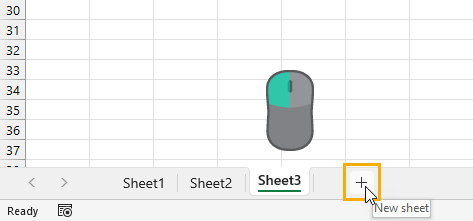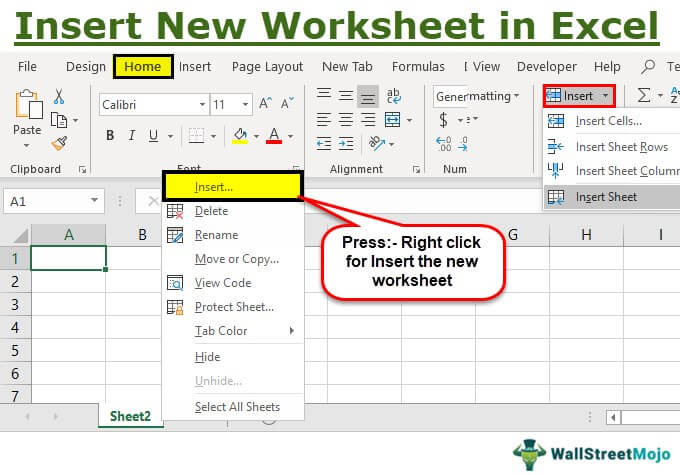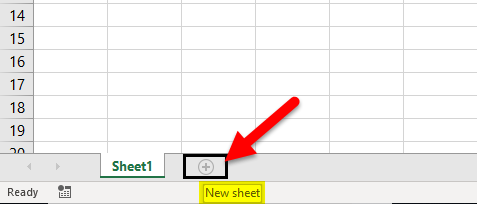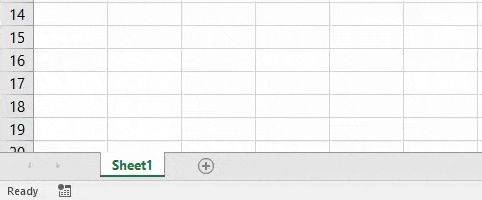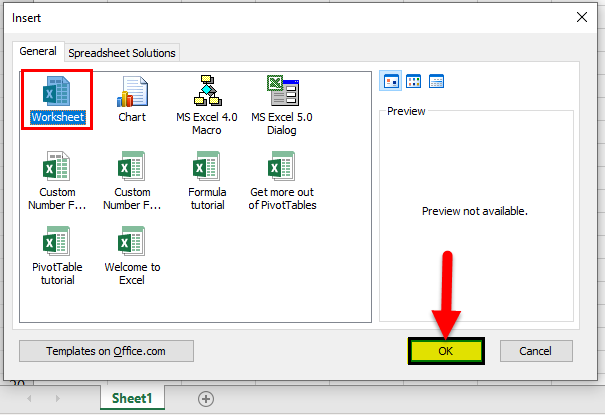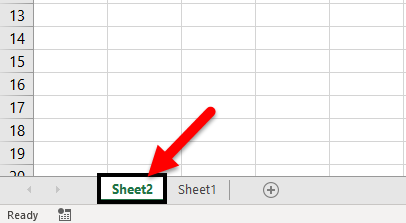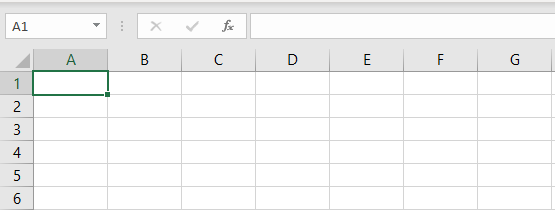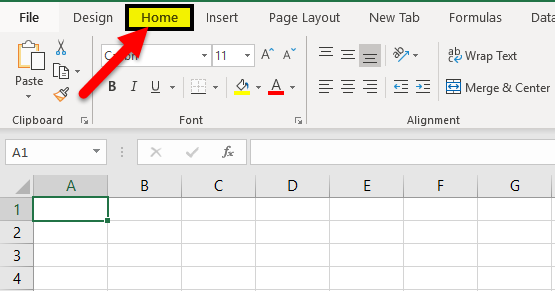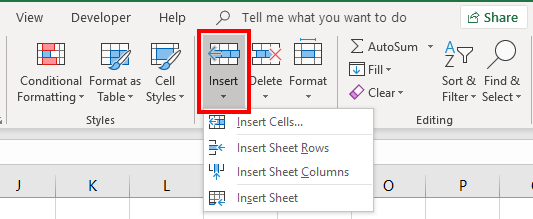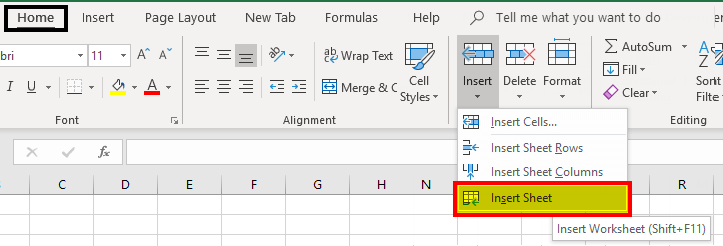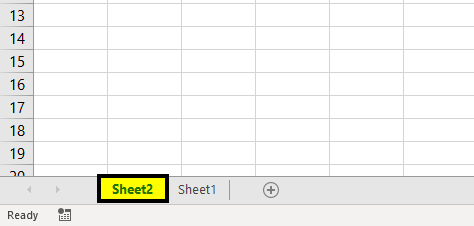Insert a worksheet
-
Select the New Sheet plus icon
at the bottom of the workbook.
-
Or, select Home > Insert > Insert Sheet.
Rename a worksheet
-
Double-click the sheet name on the Sheet tab to quickly rename it.
-
Or, right-click on the Sheet tab, click Rename, and type a new name.
Move a worksheet
-
To move the tab to the end, right-click the Sheet tab then Move or Copy > (move to end) > OK .
-
Or, click and drag to tab to any spot.
Delete a worksheet
-
Right-click the Sheet tab and select
Delete.
-
Or, select the sheet, and then select Home > Delete > Delete Sheet.
Note: Sheet tabs are displayed by default. If you don’t see them, click Options > Advanced > Display options for this workbook > Show Sheet tabs.
To insert a new worksheet, do one of the following:
-
To quickly insert a new worksheet at the end of the existing worksheets, click the Insert Worksheet tab at the bottom of the screen.
-
To insert a new worksheet in front of an existing worksheet, select that worksheet and then, on the Home tab, in the Cells group, click Insert, and then click Insert Sheet.
Tip: You can also right-click the tab of an existing worksheet, and then click Insert. On the General tab, click Worksheet, and then click OK.
Note: To change the order of the worksheets in a workbook, click the tab of the worksheet that you want to move, and then drag it to the location that you want.
What do you want to do?
-
Insert multiple worksheets at the same time
-
Change the default number of worksheets in a new workbook
-
Insert a new sheet that is based on a custom template
-
Rename a worksheet
-
Delete one or more worksheets
Insert multiple worksheets at the same time
-
Hold down SHIFT, and then select the same number of existing sheet tabs of the worksheets that you want to insert in the open workbook.
For example, if you want to add three new worksheets, select three sheet tabs of existing worksheets.
-
On the Home tab, in the Cells group, click Insert, and then click Insert Sheet.
Tip: You can also right-click the selected sheet tabs, and then click Insert. On the General tab, click Worksheet, and then click OK.
-
To change the order of the worksheets in a workbook, click the tab of the worksheet that you want to move, and then drag it to the location that you want.
Change the default number of worksheets in a new workbook
-
Click the File tab.
What and where is the Microsoft Backstage Button?
For more information about the Microsoft Backstage Button, see What and where is the Backstage?
-
Under Excel, click Options.
-
In the General category, under When creating new workbooks, in the Include this many sheets box, enter the number of sheets that you want to include by default when you create a new workbook.
-
Click any other tab to return to your file.
Insert a new sheet that is based on a custom template
-
If needed, create the worksheet template that you want to base a new worksheet on.
How to create a worksheet template
-
Select the worksheet that you want to use as a template.
-
Click the File tab.
-
Under Info, click Save As.
-
In the File name box, type the name of the worksheet template.
-
To create a custom worksheet template, type the file name that you want to use.
-
To create the default worksheet template, type sheet.
Note: Custom templates are automatically saved in the Templates folder. The default worksheet template, sheet.xltx or sheet.xltm, should be saved in the XLStart folder, which is usually C:Program FilesMicrosoft OfficeOffice14XLStart.
-
-
Do one of the following:
-
On a computer that is running Windows Vista, in the list, click Excel Template or Excel Macro-Enabled Template.
-
On a computer that is running Microsoft Windows XP, in the Save as type box, click Excel Template or Excel Macro-Enabled Template.
-
-
Click Save.
-
-
Right-click the sheet tab of a worksheet, and then click Insert.
-
Double-click the template for the type of sheet that you want.
Rename a worksheet
-
On the Sheet tab bar, right-click the sheet tab that you want to rename, and then click Rename Sheet.
-
Select the current name, and then type the new name.
Tip: You can include the name of the sheet when you print the worksheet.
How to print sheet names
-
On the Insert tab, in the Text group, click Header & Footer.
-
In the Page Layout View, click the location where you want the sheet name to appear.
-
In the Header & Footer elements group, click Sheet Name
.
-
Delete one or more worksheets
-
Select the worksheet or worksheets that you want to delete.
Tip: When multiple worksheets are selected, [Group] appears in the title bar at the top of the worksheet. To cancel a selection of multiple worksheets in a workbook, click any unselected worksheet. If no unselected sheet is visible, right-click the tab of a selected sheet, and then click Ungroup Sheets on the shortcut menu.
-
On the Home tab, in the Cells group, click the arrow next to Delete, and then click Delete Sheet.
Tip: You can also right-click the sheet tab of a worksheet or a sheet tab of any selected worksheets that you want to delete, and then click Delete Sheet.
Do you need to add a new sheet tab to your Excel workbook? This post is going to show you all the ways that you can insert a new sheet in Excel!
Excel allows you to add multiple sheets within a workbook. This is a great way to organize your spreadsheet solutions as you can separate your inputs, data, calculations, reports, and visuals into different sheets.
Organizing your workbooks with sheets can also make the spreadsheet easier to navigate for any user.
How can you add new sheets to an Excel workbook? Follow this post to find out all the ways to add sheet tabs in Excel. You’ll even learn how to add multiple sheets based on a list!
Add a New Sheet with the New Sheet Button
The quickest and easiest way to insert a new sheet in Excel is using the New Sheet button located to the right of the current sheet tabs.
Left click on the plus sign icon to the right of the sheet tabs and Excel will create a new blank sheet in your workbook!
Add a New Sheet from the Home Tab
Adding a new sheet can also be done from the Excel ribbon.
You might think this action would be located in the Insert tab, but it will actually be found in the Home tab.
Follow these steps to insert a new sheet from the Home tab.
- Go to the Home tab.
- Click on the lower part of the Insert command found in the Cells section.
- Choose the Insert Sheet option from the menu.
This will create a new sheet in your workbook.
Add a New Sheet with a Keyboard Shortcut
Good news for anyone who prefers to navigate Excel with their keyboard as much as possible! There is a dedicated keyboard shortcut for adding a new sheet.
Press Shift + F11 on your keyboard to insert a new sheet.
Add a New Sheet with Excel Options
When you create a new Excel workbook, the number of sheets it comes with will be determined by your Excel Options settings.
You can change this default so that any time you create a new workbook, it will have your desired number of blank sheets available.
The Excel Options menu allows you to customize your Excel experience with various app and workbook settings.
Follow these steps to adjust the default number of sheets in a workbook.
- Go to the File tab.
- Select Excel Options in the lower left.
- Go to the General section of the Excel Options menu.
- Scroll down to the When creating new workbooks section.
- Change the number in the Including this many sheets input.
- Press the OK button.
The next time you create a new Excel workbook, it will have your desired number of blank sheets.
💡 Tip: You can test out this new setting by pressing Ctrl + N to create a new workbook.
Add Multiple New Sheets with a Pivot Table
Did you know you can create multiple sheets from a list in the grid by using a pivot table?
This is a hidden gem for when you need to quickly create many sheets.
For example, suppose you need to create new sheets for each US state or each product that your company sells. This would be a tedious process with the previous methods.
If you have these sheet names as a list inside the grid, then you can create a pivot table based on this list and use the Show Report Filter Pages feature to generate the sheets for you.
This example shows a list of US states which can then be used to generate sheets with those US state names.
Follow these steps to automatically generate sheets from a list using a pivot table.
- Create a pivot table based on your list.
💡 Tip: Check out this post to see how to insert a pivot table from your list.
- Click and drag the sheet name field to the Filters area in the PivotTable Fields menu.
- Go to the PivotTable Analyze tab.
- Click on the Chevron icon in the Options command.
- Choose the Show Report Filter Page option from the menu.
This will open the Show Report Filter Pages menu.
- Select the field with your sheet names.
- Press the OK button.
You will only see multiple field choices in the menu if you have added multiple fields to the Filters area of your pivot table.
This will create a new sheet for each unique item in your list, and each sheet will be named based on the text in your list.
Each sheet will contain a filtered version of your pivot table in cell A1. The pivot table will be filtered on the same item as the sheet name.
Add Multiple New Sheets with VBA
VBA is a great way to automate any task for Excel in the desktop app. This includes adding sheets!
You can create a VBA macro that will create new sheets based on a selected list.
Go to the Developer tab and select the Visual Basic command or press Alt + F11 to open the visual basic editor.
📝 Note: You might need to enable the Developer tab first as it is disabled by default.
Go to the Insert menu in the visual basic editor and select the Module option from the menu.
Sub AddSheets()
Dim myRange As Range
Dim sheetTest As Boolean
Set myRange = Selection
For Each c In myRange.Cells
sheetTest = False
For Each ws In ThisWorkbook.Worksheets
If ws.Name = c.Value Or c.Value = "" Then
sheetTest = True
End If
Next ws
If Not (sheetTest) Then
Sheets.Add.Name = c.Value
End If
Next c
End Sub
Paste the above code into the new module.
This code will loop through the selected range in your workbook and will create a new sheet for each cell. If the sheet name already exists, then this item will be skipped.
Now you will be able to select any range in your workbook and run the VBA code to automatically create multiple sheets.
Add Multiple New Sheets with Office Scripts
Another way you can automate the creation of your sheets is by using Office Scripts.
Office Scripts is the JavaScript language for automating tasks in Excel online. You will need to be using Excel on the web with a business Microsoft 365 account as this feature isn’t available otherwise.
Open Excel online and go to the Automate tab and select the New Script option. This will open the Office Script editor on the right side.
function main(workbook: ExcelScript.Workbook) {
//Create an array with the values in the selected range
let selectedRange = workbook.getSelectedRange();
let selectedValues = selectedRange.getValues();
//Get dimensions of selected range
let rowHeight = selectedRange.getRowCount();
let colWidth = selectedRange.getColumnCount();
//Loop through each item in the selected range
for (let i = 0; i < rowHeight; i++) {
for (let j = 0; j < colWidth; j++) {
try {
workbook.addWorksheet(selectedValues[i][j]);
}
catch (e) {
//do nothing
};
};
};
};Add the above code to the editor and press the Save script button.
This code will loop through the selected range on your sheet and create a new sheet for each item in the range.
Now you select a range in your sheet and press the Run button in the Code Editor. This will run the code and create the required sheets in your workbook!
Add Multiple New Sheets with Power Automate
Microsoft Power Automate is a cloud-based service that makes it easy for end users to create and run automated workflows.
Users can build workflows in a matter of minutes, without any need for coding or complex configuration with the intuitive user interface.
The service can be used to automate a wide range of tasks, including sending emails, copying files, and creating records in databases.
Power Automate is part of the Microsoft Power Platform, which also includes Power BI and Power Apps. Together, these products provide a powerful end-to-end solution for business process automation.
But the best part is it’s available for use as part of any Microsoft 365 subscription!
You can use Power Automate to create sheets from a list inside an Excel Table. In this example, the desired sheet names are in an Excel Table with a column named Names.
📝 Note: This Excel file will need to be saved in either SharePoint or OneDrive in order to work with Power Automate.
Go to the Power Automate Portal and log in with your Microsoft credentials.
Then go to the Create tab and select an Instant cloud flow. This will allow you to run the flow manually with a button in the Power Automate portal.
Give your Flow a name then select the Manually trigger a flow option and then press the Create button.
This will open the flow builder and you can add steps to your workflow.
- Add a List rows present in a table step and then select the relevant file and table location in the various fields.
This action will read all the items in your table of sheet names. This will be used in the next step to create and name new worksheets.
- Add a Create worksheet step and select the same file.
- Select the Names field from the previous List rows present in a table action.
When you add the Names field to the Name input in the Create worksheet step, it will automatically add this step into an Apply to each action. This way a worksheet will be created for each item in your list of sheet names.
Press the Save button to save your flow and it will be ready to run!
Go to the My flows menu, select the Cloud flows tab, and then press the Run button for your flow.
You don’t even have to have the file open, and the sheets will be added to your workbook!
Conclusions
Most of your workbooks will need more than one sheet, so learning how to add sheets in Excel is essential.
There are manual ways to create new sheets such as the New Sheet button, the Home tab, and a keyboard shortcut. There are all great methods when you only need to add a few sheets.
There are also several methods for adding sheets in an automated manner based on a list! VBA, Office Scripts, Power Automate, and even pivot tables can all be used for situations where you need to add a lot of sheets.
Which method do you prefer for adding sheets to your workbooks? Do you have any other tips for this? Let me know in the comments section below!
About the Author
John is a Microsoft MVP and qualified actuary with over 15 years of experience. He has worked in a variety of industries, including insurance, ad tech, and most recently Power Platform consulting. He is a keen problem solver and has a passion for using technology to make businesses more efficient.
On the Home tab, in the Cells group, click Insert, and then click Insert Sheet. Tip: You can also right-click the selected sheet tabs, and then click Insert. On the General tab, click Worksheet, and then click OK.
Contents
- 1 How do you insert a new worksheet to the left in Excel?
- 2 How do I create a new worksheet in Excel with the same format?
- 3 How do I insert a new worksheet in Excel 2010?
- 4 Why can’t I add a new sheet in Excel?
- 5 How do you make changes to multiple sheets in Excel?
- 6 How do I keep formatting in the same sheet in Excel?
- 7 How do I start a new worksheet?
- 8 What is the shortcut to create a new sheet in Excel?
- 9 Where is the sheet tab in Excel?
- 10 How do you update one spreadsheet to another?
- 11 How do I add the same cell in multiple worksheets?
- 12 How do I create multiple worksheets in Excel with different names?
- 13 Can I copy formatting from one sheet to another?
- 14 How do you copy rules from one worksheet to another?
- 15 How do I create and save a worksheet?
- 16 How do you activate the worksheet shortcut menu?
- 17 What is the shortcut key for one sheet to another sheet in Excel?
- 18 Can you create a tab within a tab in Excel?
- 19 Can you create tab folders in Excel?
How do you insert a new worksheet to the left in Excel?
Here’s how:
- Select a sheet tab to highlight it.
- Press and hold the CTRL key.
- Select additional adjacent sheet tabs to highlight them.
- Select the Home tab.
- Select the Insert drop-down arrow to open the drop-down menu of options.
- Select Insert Sheet to add the new worksheets to the left of the active sheet.
How do I create a new worksheet in Excel with the same format?
Click Format on Excel’s Home menu. Choose Move or Copy Sheet.
At this point the Move or Copy dialog box appears:
- Copying within the same workbook: Click Create a Copy and then click OK.
- Copying to another workbook: Select the workbook name from the To Book list, click Create a Copy, and then click OK.
How do I insert a new worksheet in Excel 2010?
Additionally, you can add a new worksheet by right-clicking any of the worksheet tabs at the bottom of the window, then selecting the Insert option. Then click the OK button. Finally, you can also insert a new worksheet by pressing the Shift + F11 keys on your keyboard at the same time.
Why can’t I add a new sheet in Excel?
Can’t insert a new worksheet or delete an existing sheet? The option to add new sheet is greyed out? If the workbook structure is protected with a password, you’re unable to add, delete, move, copy, rename, hide or unhide any sheets. Here are 2 ways to unprotect workbook structure in Excel 2016 / 2013.
How do you make changes to multiple sheets in Excel?
1. Ctrl + Click each sheet tab at the bottom of your worksheet (selected sheets will turn white). 2. While selected, any formatting changes you make will happen in all of the selected sheets.
How do I keep formatting in the same sheet in Excel?
Select the cell with the formatting you want to copy. Select Home > Format Painter. Drag to select the cell or range you want to apply the formatting to. Release the mouse button and the formatting should now be applied.
How do I start a new worksheet?
Open a new, blank workbook
- Click the File tab.
- Click New.
- Under Available Templates, double-click Blank Workbook. Keyboard shortcut To quickly create a new, blank workbook, you can also press CTRL+N.
What is the shortcut to create a new sheet in Excel?
General Program Shortcuts
- Ctrl+N: Create a new workbook.
- Ctrl+O: Open an existing workbook.
- Ctrl+S: Save a workbook.
- F12: Open the Save As dialog box.
- Ctrl+W: Close a workbook.
- Ctrl+F4: Close Excel.
- F4: Repeat the last command or action.
- Shift+F11: Insert a new worksheet.
Where is the sheet tab in Excel?
bottom
The worksheet tab can be found at the bottom of every excel worksheet tab.
How do you update one spreadsheet to another?
Type = in your cell, then click the other sheet and select the cell you want, and press enter. That’ll type the function for you. Now, if you change the data in the original B3 cell in the Names sheet, the data will update everywhere you’ve referenced that cell.
How do I add the same cell in multiple worksheets?
Fortunately, there is a formula that can help you quickly sum up the values in the same cells in each sheet. Select a blank cell that you want to get the calculating result, and then type this formula =SUM(Sheet1:Sheet7! A2) into it, and press Enter key. Now the result will be gotten in the selected cell.
How do I create multiple worksheets in Excel with different names?
Follow these steps:
- Select any worksheet name in the column.
- Display the Insert tab of the ribbon.
- Click the PivotTable tool, at the left side of the ribbon.
- Click OK.
- In the PivotTable Fields pane, click the checkbox next to the field used for your list of worksheets.
Can I copy formatting from one sheet to another?
you can also copy formatting to another sheet or another workbook. Simply select the cell from where you want to copy the formatting, enable format painter, select the sheet/workbook where you want to paste it, and select the cells in the destination sheet.
How do you copy rules from one worksheet to another?
Copy Conditional Formatting in the Same Sheet (or different sheets)
- Select the cell or range of cells from which you want to copy the formatting.
- Right-click and then click on Copy (or use the keyboard shortcut Control + C)
- Select the range of cells where you want to copy the copied conditional formatting.
How do I create and save a worksheet?
Save a worksheet
- Right-click the worksheet name tab.
- Click select Move or Copy.
- Click on the Move selected sheets to Book drop-down menu. Select (new book).
- Click OK. Your new workbook opens with your moved worksheet.
- Click File > Save in your new workbook.
Another quick way to display the shortcut menu is to press (Shift + F10). You can activate a shortcut menu almost anywhere and there are over fifty pre-defined menus. The menu below is the shortcut menu that is displayed when you have a cell selected. Select the cell “B2” and then press the right mouse button.
What is the shortcut key for one sheet to another sheet in Excel?
You can easily move between worksheets in a workbook by using Ctrl+Pg Up and Ctrl+Pg Down.
Can you create a tab within a tab in Excel?
Hold down [Shift] and click the first and last sheet tabs to create a contiguous group (Figure A). You’ll notice that the tabs change color when grouped. Use [Ctrl] to click individual tabs to create a group of noncontiguous sheets.
Can you create tab folders in Excel?
In the left panel, right-click the location where you’d like to add the new folder—the Sheets directory, another folder, or a workspace— and select Create New > Folder. Enter a folder name and then click OK.
A worksheet is a sheet in a workbook. The workbook is the name of an Excel file, and that workbook contains one or more worksheets.
The worksheet is a single page inside a file designed with an electronic spreadsheet program like Microsoft Excel. The worksheet is used to accumulate data or to work with data. We all know that we cannot work on a single worksheet in Excel as it has a limited number of cells, rows, and columns. Therefore, we need to have multiple worksheets with a big database.
We also need to know how to insert a new worksheet in excel on the existing worksheet. Again, this has been explained above through various examples.
Table of contents
- Insert New Worksheet In Excel
- How to Insert a New Worksheet in Excel?
- Example #1 – Shortcut Keys for Insert New Worksheet In Excel
- Alt + Shift Shortcut #1
- Shift + F11 Shortcut #2
- Example #2 – To Insert a New Worksheet Using the Mouse
- Example #3
- Example #4
- Things to Remember in Insert a New Worksheets in Excel
- Recommended Articles
You are free to use this image on your website, templates, etc, Please provide us with an attribution linkArticle Link to be Hyperlinked
For eg:
Source: Insert New Worksheet in Excel (wallstreetmojo.com)
How to Insert a New Worksheet in Excel?
We have learned these ways to insert a worksheet into an excel file:
- Using Excel Shortcut KeysAn Excel shortcut is a technique of performing a manual task in a quicker way.read more.
- Using Insert Tab
There are multiple ways to insert a new worksheet in excel. Inserting a new worksheet is quite simple.
Let us discuss it one by one with a few examples.
Example #1 – Shortcut Keys for Insert New Worksheet In Excel
There are two shortcut keys to insert a new worksheet in Excel, They are:
Alt + Shift Shortcut #1
- Click on the ALT button from the keyboard hold it.
- Now click on the Shift button from the keyboard hold it along with the ALT button.
- Click on the F1 key from the keyboard then release it.
- Now release the alt and shift keys.
Now, we will add a new worksheet to an open workbook.
Shift + F11 Shortcut #2
Step #1 – Click on the ‘SHIFT” button from the keyboard.
Step #2 – Click on the ‘F11’ key from the keyboard & release it.
Step #3 – Now release the “shift” key.
Now, we will add a new worksheet to an open workbook.
Example #2 – To Insert a New Worksheet Using the Mouse
Step #1 – We will find a “+” sign at the bottom of the sheet highlighted in dark red in a workbook.
Step #2 – Click on the “+” sign to insert a new worksheet in Excel, as shown below.
Example #3
There is another way to insert a new worksheet in Excel. Let us understand it with an example.
Step #1 – Open a new workbook, as shown below.
Step #2 – Now, right-click on the existing sheet named as ‘Sheet1’ by default
Step #3 – From the above image, click on the “INSERT” option to insert anything. Then, you will get a pop-up, as shown below.
Step #4 – Now, select the “Worksheet” option to insert a new worksheet and click on the “OK” button.
From the above image, we can see the second sheet, named “Sheet 2.” By default, this is the sheet inserted by us using the third procedure.
Example #4
Let us see a new way to insert a new worksheet in Excel, which is another easy and simplest way to insert a worksheet. In this procedure, we will use the “INSERT” option available in the Ribbon bar of an excel.Ribbons in Excel 2016 are designed to help you easily locate the command you want to use. Ribbons are organized into logical groups called Tabs, each of which has its own set of functions.read more
Let us understand it with the help of an example.
Step #1 – Open a new workbook, as shown below.
Step #2 – Click on the ‘Home’ tab available in the Ribbon bar of a workbook.
Step #3 – We may find an “Insert” tab on the right side of a ribbon bar under the “Home” tab.
Step #4 – Now, click on the “Insert” icon available on the right side of the ribbon bar to open a drop-down list of options to be selected.
Step #5 – We will find an “Insert Sheet” option available at the end of the drop-down list.
Step #6 – Click on the “Insert Sheet” option available at the end of the drop-down list to insert a new worksheet in Excel, as shown below.
The above figure shows that the second sheet named “Sheet2” has been added to a workbook.
Things to Remember in Insert a New Worksheets in Excel
- A workbook can contain 255 Worksheets.
- A workbook may be slow to use with many worksheets and formulas.
Recommended Articles
This article is a guide to Insert New Worksheet In Excel. Here, we discuss inserting a new worksheet in Excel using shortcut keys and practical examples. You may learn more about Excel from the following articles: –
- Protect Sheet in VBAVBA Protect Sheet is an In-built function that protects the worksheet with a password & prohibits the users from editing, deleting, or moving the contained data. read more
- Rows and Columns in ExcelA cell is the intersection of rows and columns. Rows and columns make the software that is called excel. The area of excel worksheet is divided into rows and columns and at any point in time, if we want to refer a particular location of this area, we need to refer a cell.read more
- Group Worksheets In ExcelGrouping gives the best results to users when the same type of data is presented in the cells of the same addresses. Grouping also improves the accuracy of data and eliminates the error made by a human in performing the calculations.read more
- Protect Sheet in ExcelWhen we don’t want any other user to make changes to our worksheet, we can use the Protect worksheet feature in Excel. It can be found in Excel’s Review tab. read more
Working with MS Excel means working in the worksheets in Excel.
A worksheet is an area that has all the cells where you can store data, enter formulas, insert charts and create reports and dashboards.
When you open a new Excel workbook file, by default there is only one worksheet. Earlier versions of Excel (2013 or 2016 used to have 3 worksheets by default)
There are some simple shortcuts and techniques that you can use to quickly insert new worksheets in the same workbook in Excel.
In this tutorial, I will show you a couple of methods that you can use to insert a new worksheet in the same workbook (one at a time).
I will also show you a method to quickly insert worksheets in bulk, in case you want to add 5, 10, or 20 worksheets in one go (using a simple VBA code).
So let’s get started!
Keyboard Shortcut to Insert a New Worksheet
If you are a fan of keyboard shortcuts, this is probably the fastest way to insert a new worksheet in an already open workbook in excel.
Below is the keyboard shortcut to insert a new worksheet
SHIFT + F11
For this shortcut, hold the SHIFT key and then press the F11 key.
Another keyboard shortcut that does the same job is ALT + SHIFT + F1 (hold the ALT and the SHIFT keys and press the F1 key)
Personally, I find using the keyboard shortcut to be the best way to insert a new worksheet in Excel. Even if I have to insert multiple worksheets (say 3 or 5 or 10), I can still do that very quickly
Insert New Sheet Using the Plus Icon
If you’re not a big fan of keyboard shortcuts and prefer using the mouse instead, this method is for you.
At the bottom of your worksheet (in the area that has all the sheet names), you will see the plus icon.
Clicking on this plus icon will immediately insert a new worksheet.
Insert New Sheet Using the Insert Dialog Box
Another way to insert a new sheet in Excel is by using the Insert dialog box.
Below are the steps to do this:
- Right-click on any of the sheets
- Click the Insert option

- In the Insert dialog box, make sure Worksheet is already selected (which is also the default option).

- Click on Ok
While this is not the fastest way to add a new sheet in an Excel workbook, it’s good to know as it gives you access to some other things as well.
Apart from inserting a regular worksheet, you can also use this to insert a ‘Chart Sheet’ or a ‘Macro Sheet’ using the insert dialog box.
If you’re wondering, a Chart Sheet is just like a worksheet but is meant only to hold a chart. A macro sheet is something that was used earlier before the VBA days and is no longer used.
In most cases, you won’t be needing these, but it’s good to know.
There is also the Spreadsheet Solutions tab that holds some of the templates. You can also create and get your own templates here. So the next time you need to quickly insert a template, you can do it from here.
Adding New Worksheets Using the Insert Tab in the Ribbon
And finally, you also have an option in the Excel ribbon to add a new worksheet.
To do this:
- Click the Home tab

- In the Cells group, click on the Insert option

- Click on the Insert Sheet option.

This will insert one new worksheet in the open workbook
How to Insert Multiple Worksheets in One Go (One Line VBA Code)
So far, the methods that I have shown you insert one new worksheet at a time.
In case you want to insert multiple worksheets, you would have to use these methods again and again (i.e., use the keyboard shortcuts multiple times or use the plus icon multiple times).
While this works fine in most cases, if you have to insert worksheets in bulk, saying so 10 or 20 or 30 worksheets in one go, then this could be time-consuming and error-prone.
So let me show you a better way to insert multiple new worksheets in one go.
This can be done easily using a simple one-line VBA code:
Sheets.Add Count:=10
The above code would instantly add 10 new sheets in the workbook in which it’s run (if you want any other number of sheets to be added, just change the value in the code)
Below are the steps to run this macro code:
- Click the Developer tab (or use the keyboard shortcut ALT + F11) and then click on Visual Basic
- If you don’t see the immediate window in the VB Editor, click on the View option and then click on Immediate window

- Copy and paste the above code in the immediate window

- Place the cursor at the end of the VBA code line and hit Enter
As soon as you hit Enter, it would instantly insert 10 new sheets in the workbook. In case you want to insert more (say 20 or 30), just change the number in the code
The good thing about using this code is that you can be sure that it would insert the right number of sheets (no chance of human error if the code is executed without any errors).
In case you need to do this quite often, you can use the below code and paste it into our Personal Macro workbook.
Sub AddSheets()
Sheets.Add Count:=10
End Sub
Once in Personal Macro Workbook, you can add it to the Quick Access Toolbar so you always have access to it in the workbook.
This way, you can easily add 10 or 20 sheets with just a single click.
Changing the Default Number of Sheets with New Excel Workbooks
If you always have a need for more worksheets in the workbook, you can change the default number of sheets you get when you open a new Excel file.
For example, you can change the setting so that you always get 5 or 10 sheets by default with every newly opened workbook.
Below are the steps to change this default setting:
- Open any Excel workbook
- Click the File tab

- Click on Options. This will open the Excel Options dialog box
- In the Excel Options dialog box, make sure the General option is selected in the left-pane

- In the ‘When creating new workooks’ section, enter the number of sheets you want (in the Include this many sheets value).

- Click OK
Now when you open a new Excel workbook, it will have the specified number of worksheets.
Note that an Excel file can have a maximum of 255 sheets.
These are all the ways you can use to insert a new sheet in Excel. In most cases, you only need to add one or a couple of new sheets, so you can use the keyboard shortcut or the plus icon in the worksheet.
And in case you have a need to insert many new sheets in bulk, you can use the VBA code. Alternatively, you can also change the default number of sheets in any new Excel workbook.
I hope you found this tutorial useful!
Other Excel tutorials you may also like:
- How to Delete Sheets in Excel (Shortcuts + VBA)
- How to Rename a Sheet in Excel (4 Easy Ways + Shortcut)
- How to Print Excel Sheet on One Page (Fit to One Page)
- How to Group Worksheets in Excel (Step-by-Step)
- How to Compare Two Excel Sheets (for differences)
- How to Move Chart to New Sheet in Excel?
- Count Sheets in Excel (using VBA)

 at the bottom of the workbook.
at the bottom of the workbook.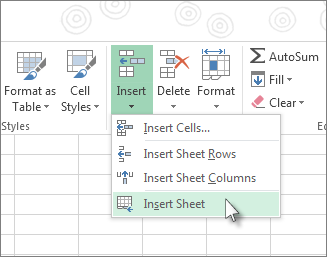
 Delete.
Delete.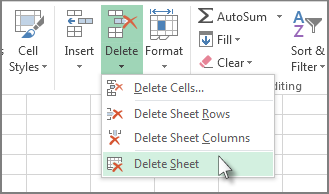



 .
.